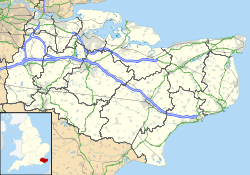The Corn Exchange is a former chapel, trading facility and military installation at Bank Street (formerly Back Street) in Tonbridge, Kent.
| The Corn Exchange | |
|---|---|
| Tonbridge | |
 The Corn Exchange | |
| Coordinates | 51°11′51″N 0°16′29″E / 51.19761°N 0.27466°E |
| Type | Drill hall |
| Site history | |
| Built | 1791 |
| Built for | War Office |
| In use | 1791-Present |
History
editThe building was originally commissioned as a chapel for the Independent Congregationalists and was referred to as the "Independent Chapel".[1][2] It was built in red brick and completed on 19 March 1791.[3] The design involved a main frontage of three bays facing onto Bank Street, which was previously known as Back Street.[4] The central bay featured a small portico formed by four columns supporting an entablature. The outer bays were fenestrated by mullioned and transomed windows with pointed heads and hood moulds. The frontage was surmounted by a pediment with a circular panel containing a trefoil in the tympanum. The building was enlarged in 1847.[5]
The Independent Congregationalists moved out to new premises in the High Street in 1876 and the chapel became used as the local Corn Exchange.[6] However, the use of the building as a corn exchange declined significantly in the wake of the Great Depression of British Agriculture in the late 19th century.[7]
The building was then converted to become the headquarters of the 4th Battalion, The Queen's Own (Royal West Kent Regiment) in 1910.[8] It also became the headquarters of the Kent Cyclist Battalion at this time.[8] The 4th Battalion was mobilised at the drill hall in August 1914 before being deployed to India.[9][10]
The battalion merged with the 5th Battalion to form the 4th/5th Battalion in 1947.[11] Following the cut-backs in 1967, the presence at the drill hall was reduced to a single company, E Company, 5th (Volunteer) Battalion, The Queen's Regiment.[12] The drill hall was subsequently decommissioned and converted for commercial use.[13]
See also
editReferences
edit- ^ "History". Christ Church United Reformed Church. Retrieved 19 April 2023.
- ^ Lists of chapels belonging to the Church of England and places of public worship, registered for solemnization of marriages, also of all superintendent registrars, and deputy superintendent registrars; registrars of marriages, and of registrars of births and deaths, and deputy registrars. 1839.
- ^ "Christ Church URC". Touch 2000 (Tonbridge United Churches 2000) history project. L.M. Simms, TOUCH 2000/Tonbridge United Churches and Keith Halstead. 2000–2012. Archived from the original on 9 February 2009. Retrieved 14 February 2013.
- ^ Booker, John Michael Lloyd (1 November 1984). "The Architecture of Banking: A study of the Design of British Banks from the 18th Century to Modern Times" (PDF). University of York. p. 105.
- ^ "Old Tonbridge in pictures: Other churches". Tonbridge Historical Society. Retrieved 19 April 2023.
- ^ "Tonbridge Timeline". Tonbridge History. Retrieved 19 April 2023.
- ^ Fletcher, T. W. (1973). 'The Great Depression of English Agriculture 1873-1896' in British Agriculture 1875-1914. London: Methuen. p. 31. ISBN 978-1136581182.
- ^ a b "Tonbridge". The drill hall project. Retrieved 23 September 2017.
- ^ "Queen's Own Royal West Kent Regiment". The Long, Long Trail. Retrieved 19 April 2023.
- ^ "Bank Street drill Hall". Kent in World War I. Retrieved 24 September 2017.
- ^ "4th Battalion, The Queen's Own Royal West Kent Regiment". Regiments.org. Archived from the original on 14 February 2006. Retrieved 24 September 2017.
- ^ "5th (V) Battalion, The Queen's Regiment and The Princess of Wales's Royal Regiment". Regiments.org. Archived from the original on 23 February 2006. Retrieved 24 September 2017.
- ^ "Bobbett Design". Creative Match. Archived from the original on 24 September 2017. Retrieved 24 September 2017.
